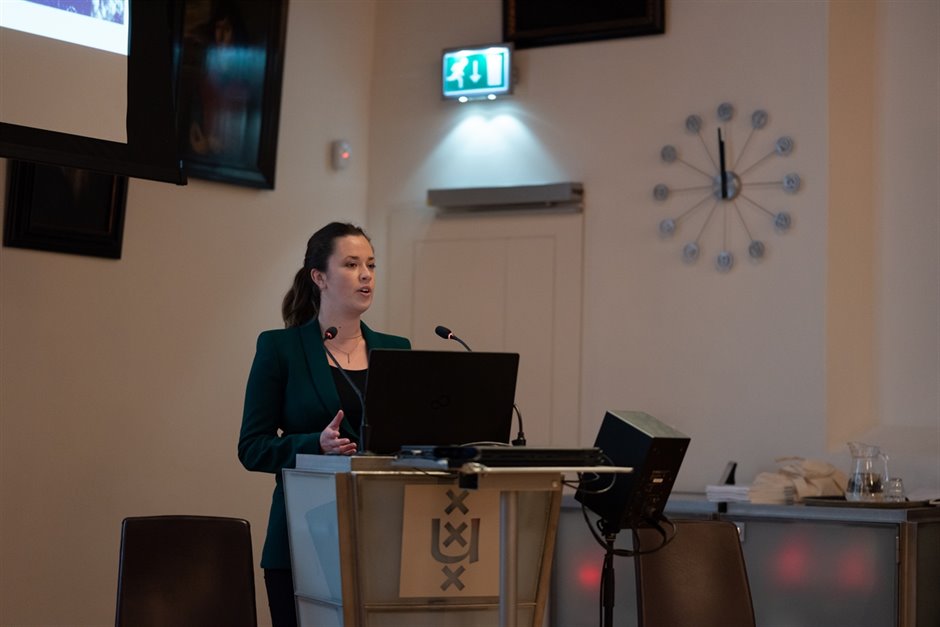‘It is interesting to understand how environmental factors influence the behaviour of migratory birds over the North Sea’
‘From a young age, I enjoyed observing animals. Later on I realized that their movements are fascinating. I have always been passionate about nature conservation, so this project was a combination of my multiple passions.' This was how Maja Bradarić started enthusiastically on her PhD research at the UvA. She successfully completed her research degree in this subject at the end of 2022. Not only did it generate lots of data on night-time bird migration over the North Sea, it also led to a predictive bird migration model. This model forms an important part of a curtailment procedure in relation to offshore wind energy: the (more or less complete) stopping of wind turbines whenever large flocks of birds are expected to migrate over sea at rotor height. Maja Bradarić tells the story behind her research degree and the results. She has since then started in-depth follow-up post-doctoral research.
In March 2018 you started your PhD-project. How did you know about it? Why did you choose this project?
When people ask me what kind of scientist I am I like to say that I’m a movement ecologist. I have always been fascinated by movements of animals: all the things that we can learn of why they move and how they move. My broad interest is how does environment change certain animal behaviours, such as movement.
The world is changing, there are many more anthropogenic influences on the general ecosystems. It is interesting from the fundamental scientific perspective to understand: how do animals cope with that. How do they adapt to that; do they adapt to that? But it also gives us knowledge with which we can create these management practices. From a young age, I’ve been passionate about animal conservation. So when I read about this project and I saw the advertisement I thought: this sounds perfect, it is like a combination of my multiple passions.
I think this research is unique. It’s only now, the last two years, that I’ve seen similar projects in other European countries. But no one has put it into practice. The Netherlands was the first to take this brave step. It feels great to be there, in the forefront.

Your research led to very interesting results. Which one surprised you most?
There are multiple things that were kind of surprising but the result I would like to point out and that I would like to explore a little bit more is how birds navigate the North Sea in different seasons. It seems that in spring they do not necessarily use the same migration routes as they do in autumn.
Animals tend to change their behaviour around large ecological barriers. So what we see now is probably an adaptive behaviour of how to navigate a big ecological barrier like the North Sea. This is all theoretical. I will need much more data to prove it and to explore it. This is wat I hope to do in the next part of my research.
For your research you worked together with stakeholders like the wind farm companies.
This collaboration with the stakeholders was also very unusual. It was challenging, especially in the beginning. But I really enjoyed the knowledge exchange. I learned a lot and I gained some extra skills. I got a better overview of the project and a more general picture of how things work and how things are set up. I understand more about policies and the energy grid, like: why is it that we can use predicting models in some ways and why can’t we use those models in some other ways? It sometimes was a true eye opener. You’re not only in your own ecological bubble.
That’s what makes this project special: from the very beginning researchers, policy makers and industry were collaborating. It’s an example for the future of how we should work together.
The whole attitude of the wind farm industry was much better than I expected. The wind farm owners are very interested in exploring the possibilities for the fine-tuning of the predictive model and adjusting it more to the specific locations. With the next part of my research, I am also aiming to address some of their concerns.
So you’ll be continuing your research?
I have already started working on developing the plan. The project is supported by the Wozep programme (Offshore Wind Ecological Programme) as well as the Start/Stop group of Rijkswaterstaat. After learning more and after collecting more data, we’re going to work on improving the predictive model for the wind energy companies. One of the main things we want to explore are the spatial differences between different radar locations. We will have more radars and also we’ll have one of the radars very far out in the sea, right between the UK and the Netherlands. I’m really excited to explore how migration patterns differ between different locations in the North Sea. Because it’s not only the weather, one of the main things, but there is also topography that’s influencing how birds are going to navigate certain areas. The distance from the coast for example can also influence different behaviours in bird migration. So we might fine-tune the models to different locations. In the end we might not have one general model but we will instead have multiple models.
We already have surprisingly good results, but with more data and more years and more knowledge we would like to make the model more robust and reliable. Think for example of the weather forecast: we still make mistakes. It’s similar to bird migration: there’s a lot we don’t know but we made huge progress with a very small amount of data.
For more about ‘On the radar: weather, bird migration and aeroconservation over the North Sea’ see the UvA website: PhD defence ceremony Maja Bradarić - Institute for Biodiversity and Ecosystem Dynamics - University of Amsterdam (uva.nl).